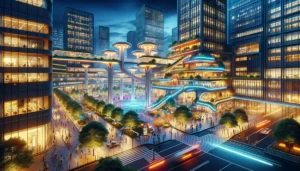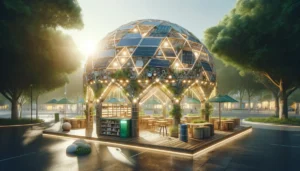Introduction
Lighting in industrial design transcends its basic functionality of illuminating spaces, evolving into a crucial element that defines the atmosphere, mood and even the identity of an environment.
At the intersection of style and innovation, lighting becomes an artistic and technical expression, reflecting cultural trends and technological advances.
This article explores how different lighting approaches in industrial design shape our experiences in inhabited spaces and influence the aesthetic and functional perception of our environment.
By delving into the varied styles and technological innovations, we will uncover how industrial lighting has adapted and transformed over time, responding to emerging needs for sustainability, efficiency and artistic expression.
The Evolution of Lighting in Industrial Design
The history of lighting in industrial design is a fascinating tale of innovation and stylistic adaptation. From the first incandescent bulbs of the late 19th century to modern high-efficiency LED solutions, the trajectory of industrial lighting reflects a constant push and pull between form and function, aesthetics and energy efficiency.
In the beginning, lighting was purely functional, with little or no thought given to design or style. Lamps were utilitarian objects, intended to illuminate factories and workshops. However, as electricity became more affordable and societies became more design-conscious, lighting began to take on a more central role in industrial design.
The Art Deco era, for example, brought with it elegant lighting fixtures that not only provided light but also served as style statements, reflecting the era’s ideals of modernity and luxury. This period marked the beginning of the fusion of functionality and aesthetics in industrial lighting.
The move into the modern era saw the introduction of new materials and technologies, allowing for bolder designs and innovative shapes. The modern design era, with its clean lines and minimalist approach, favored functionality, but always with an eye on style. The introduction of LED technology further revolutionized the field, offering unprecedented energy efficiency, extended lamp life, and endless design possibilities due to its compact size and versatility.
Today, technological innovation continues to drive the evolution of industrial lighting design. With the advent of the Internet of Things (IoT) and smart lighting, luminaires are no longer just light sources, but integrated components of broader domestic and industrial systems, capable of altering environments and improving energy efficiency through automated adjustments and customization.
Thus, the evolution of lighting in industrial design reflects a continuous journey of adaptation and innovation, where form follows function, and style intertwines with technology, creating lighting solutions that illuminate not only our spaces, but also our lives.
Key Elements of Industrial Lighting Design
In industrial lighting design, harmony between materials, technology and functionality is key to creating solutions that not only meet practical needs but also aesthetically enrich spaces. Each element plays a crucial role in defining the character and effectiveness of a luminaire, contributing to the diversity of styles and applications in the field of industrial design.
Materials: The Basis of Design
The materials used in industrial lighting fixtures vary widely, from traditional metals like steel and aluminum to modern plastics and advanced composites. Each material brings its own aesthetic and functional properties. Metal, for example, is often associated with industrial and vintage designs, offering durability and classic style. The use of glass and acrylic allows for soft light diffusion, suitable for environments seeking a more welcoming and less utilitarian atmosphere. Sustainable materials like wood and recycled plastics reflect a growing interest in green design practices, creating pieces that are both functional and environmentally conscious.
Technology: The Heart of Innovation
Technology is the engine that drives innovation in industrial lighting design. The adoption of LEDs has radically transformed the industry, offering an unmatched combination of energy efficiency, durability and design flexibility. LED technology enables the creation of compact luminaires that can be molded into shapes that would be impossible with traditional lamps. In addition, advances in lighting control technology, such as smart systems and motion sensors, expand the functionality of luminaires, allowing them to dynamically adapt to environments and user needs.
Functionality: The Purpose of Design
Functionality remains the central pillar of industrial lighting design. In addition to providing light, luminaires are designed to meet specific requirements, such as being resistant to harsh conditions in industrial environments or being able to promote well-being in workspaces. Directional lighting, for example, is essential in manufacturing environments for tasks that require precision, while indirect and adjustable lighting solutions are preferred in office spaces to minimize eye strain and create a more comfortable working environment.
Application Examples
The application of these elements can be seen in designs such as industrial-style pendant lights, which use robust metals and simple lines to create a dramatic and functional effect in commercial and residential spaces. Another example is recessed LED lighting, which integrates seamlessly into modern architecture, providing efficient and discreet lighting, ideal for creating spaces with minimalist design.
By balancing these key elements, industrial lighting design can meet a wide range of needs, creating solutions that not only illuminate, but also define the character of the spaces in which we live and work.
Lighting Styles in Industrial Design
Industrial lighting design encompasses a variety of styles, each reflecting distinct philosophies and approaches. These styles not only influence the aesthetics of a space, but also incorporate technological innovations and responses to cultural and environmental trends.
Minimalist: The minimalist style emphasizes simplicity, with clean lines and a neutral color palette. Minimalist lighting often uses simple geometric shapes and hides complex elements, emphasizing functionality without excess decoration. This style reflects the philosophy of “less is more,” where beauty lies in simplicity and clarity of form.
Industrial: Inspired by the factories and warehouses of the early 20th century, the industrial style is characterized by the use of raw, robust materials such as metal and wood. Industrial-design lighting fixtures often feature functional elements such as screws and gears as part of their aesthetic appeal, evoking a sense of rusticity and authenticity.
Eco-friendly: Eco-friendly style focuses on sustainability and environmental impact, using recycled or renewable materials and energy-efficient technologies such as LEDs. This style reflects an environmental consciousness, integrating natural and organic elements into the design to create harmonious and sustainable spaces.
Futuristic: Futuristic style incorporates innovative forms and advanced technology, exploring the potential of smart lighting and new materials. With a focus on dynamic lines and unconventional shapes, futuristic lighting seeks to anticipate the future of design, reflecting an optimistic and progressive vision of technology.
Innovation and Sustainability in Lighting
Sustainability has become a central pillar in lighting design innovation, driving the development of technologies that not only improve energy efficiency but also reduce environmental impact. The adoption of LEDs has revolutionized the sector, offering a low-energy alternative to traditional bulbs, with a significantly longer lifespan and lower heat emission.
In addition to LED, solar lighting is gaining ground, especially in outdoor applications. Using solar panels to convert sunlight into electrical energy, solar lighting eliminates the need for conventional energy sources, reducing the carbon footprint and promoting energy autonomy.
Recyclable and low-impact materials are also becoming more prevalent in lighting design. The use of recycled plastics, glass and metals, along with sustainably sourced wood, reflects a move towards more responsible manufacturing practices. This approach not only minimizes waste but also promotes circularity, where products are designed to be recycled or reused at the end of their useful life.
The integration of sustainable practices into lighting design is not only a response to growing environmental concerns, but also a reflection of consumer demand for products that align aesthetics, functionality and eco-responsibility. As innovation continues to drive the industry, sustainability is firmly established as a driving force in the development of new lighting solutions.
Innovative Industrial Lighting Projects
A notable example is the “City Lights” project, where high-efficiency LED luminaires were integrated into urban structures, combining functionality with public art. This project not only improved public lighting, but also transformed urban areas into vibrant and welcoming spaces.

Another example is the “Eco-Light Pavilion”, an installation that uses recyclable materials and solar energy, highlighting the potential of sustainability in lighting design.

Conclusion
This article explored the dynamic interplay between style and innovation in industrial lighting design. We saw how materials, technology and functionality intertwine to create styles ranging from minimalist to futuristic, each reflecting different design philosophies. Sustainability has emerged as a central theme, with technologies such as LED and solar solutions paving the way for a greener future. As we move forward, industrial lighting design will continue to evolve, shaped by continued innovation and a growing emphasis on sustainability, promising to transform not only our spaces, but also our relationship with the environment.
